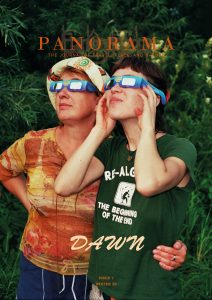Amsterdam’s Museum Van Loon, a mansion built in 1672 and previously inhabited by descendants of one of the Dutch East India Tea Company founders, was originally established in 1973 to showcase how wealthy merchants of the Netherlands lived in the 17th and 18th centuries. Prior reviews of the permanent exhibition have highlighted the more than fifty family member portraits painted in the 17th century, which is defined as the golden age of Dutch painting. While these paintings still adorn the walls during the current special exhibit, they are dull compared to the histories of those colonised by the occupants, which are brought to life through an immersive, theatrical exhibit inviting participants to travel through walls and across time.
The website warns prospective visitors for this special exhibition that “eight rooms of the house have been overtaken by built-in boxes with semi-transparent fabric. This means that the interiors are NOT on view in their regular settings.” The result is that as one explores the mansion, spaces in which primarily servants worked—such as the kitchen and stable—are left exposed and intact, while the spaces primarily utilised by the homeowners—such as the bedrooms, the reception room, and dining room—are transformed. Much of the furniture of the wealthy inhabitants is partially hidden behind scrim, a special fabric used often in theatrical productions. When scrim is lit from the front, it does not reveal what lies behind it. When the scrim is backlit, hidden objects seem to magically appear.
In the reception room, scrim that is front lit is used to hide the ornate legs of a stone side table and standing lamp that once belonged to wealthy Dutch homeowners. Instead, only the surface of the table is visible. It displays family photos of Hendrina Heirath and Dirk Andreas Ralf, who met and married as enslaved people while working on plantations owned by the Van Loon family. These plantations were located in Suriname in northern South America—far from the Netherlands. The exhibit emphasises that Hendrina and Dirk’s story is one of many that exemplifies the far-reaching impact of Dutch colonialism. Additional artefacts in the living room that are specific to this exhibit include a family tree tracing Hendrina and Dirk’s descendants, photos of the family home they bought after leaving the plantations, and an audio track recounting the extensive history of the family which has ties to Ghana, Indonesia, and Thailand. This reimagined reception room highlights the ubiquitous influence of the Van Loon family and other wealthy Dutch elite on individuals across borders, oceans, and generations.
In the dining room, scrim is used to upend power. Traditionally, in this room the homeowners would host guests over lavish, multi-course meals. This may have included discussing business that would lead to further oppression of people colonised and enslaved for the profit of the Dutch East India Tea Company. Here, the scrim with front light hides half of the long table. Instead, one sees half of the table with four place settings in front of four empty chairs. In place of the hidden half of the table and four missing chairs, four video screens appear slightly above and across the table from the four visible place settings. The screens feature videos of individuals living in the present time who are descendants of groups colonised by powerful individuals associated with the home. So, one descendant is on screen directly across from one empty dining room chair.
The porcelain tableware that would traditionally be set on the dining room table sits in a cupboard on an adjacent wall, intentionally half-visible through backlit scrim. Instead, the dining room table is set with food and artifacts like a coconut and a banana tree leaf representative of each descendant’s native land. A place card sits in front of each empty chair noting the name of one of four powerful men associated with the Van Loon family and the Dutch East India Tea Company. Two of the place cards show only silhouettes of the men, which depersonalizes them—akin to how enslaved people were depersonalized by colonial rulers.
The descendants on the video take turns speaking in their native languages, bringing to life past injustices done to their ancestors as they confront the empty, still chairs. In this newly conceptualized dining room, one may infer that descendants and ancestors finally have seats at the table as they hover together above and across from the empty seats of the long-deceased wealthy oppressors. The descendants and their ancestors regain power through claiming their own seats at the table—creating space for their histories.
This special exhibit is a collaboration between Amsterdam’s Imagine IC and Speak Up World organisations and the Van Loon Museum. Imagine IC is a community-based organisation whose mission aims for a society in which everyone participates equally. Speak Up World is a community platform for Black, Indigenous and People of Colour that aims to foster personal development, healing, and growth by creating safe spaces to discuss social issues. The result of this collective effort provides participants with an up-to-date experience of this conventional manor and may arguably be the refresh model needed for similar museums and tourist attractions created from former homes of the elite around the world.
Imagine IC and Speak Up World’s exhibition Says Who? Creating space for histories is on display from April 7-July 16, 2023, at the Museum Van Loon, Keizersgracht 672, 1017 ET Amsterdam.














